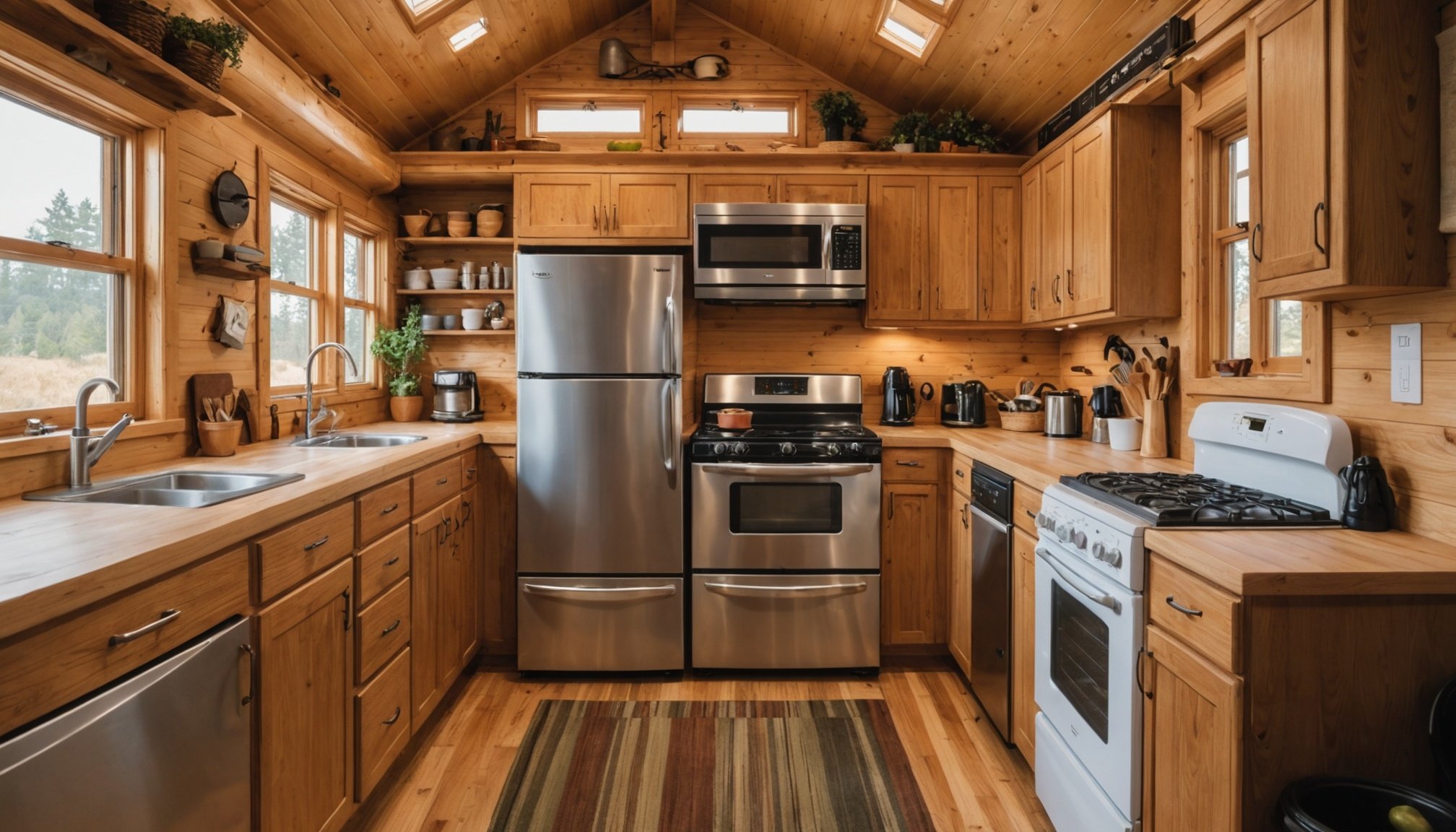Overview of Energy-Efficient Appliances
Understanding energy-efficient appliances is vital for anyone committed to sustainable living, particularly in a tiny home kitchen. These appliances are designed to use less energy while maintaining performance, thus reducing utility bills and environmental impact. For tiny living, sustainability hinges on maximizing space and minimizing strain on resources. By investing in energy-efficient models, homeowners not only cut energy consumption but also contribute positively to environmental conservation.
Definition and Benefits
Energy-efficient appliances typically feature advanced technology that reduces power use during operation. This can include inverter compressors or timed cycles, which lead to significant energy savings over time. These appliances help in saving money by lowering electricity bills, an essential factor when living in smaller homes with potentially limited budgets.
Also read : Transform Your Minimalist Living Room with Cutting-Edge Aquarium Design Techniques
Importance of Sustainability in Tiny Living
In a tiny home kitchen, every inch matters, as does every watt of energy. Choosing energy-efficient appliances is crucial in such settings because they offer practical solutions by conserving space and energy. They ensure that people live comfortably without compromising on sustainability.
Conclusively, understanding the role of energy-efficient appliances and their benefits sets the foundation for making informed purchasing decisions for compact, energy-conscious living spaces.
Also read : Crafting your dream succulent sanctuary: essential tips for flourishing in dry climates
Categories of Energy-Efficient Appliances
When it comes to reducing energy consumption in your tiny home kitchen, selecting the right categories of energy-efficient appliances is crucial. These choices not only lower your utilities but also contribute to a sustainable lifestyle.
Refrigerators and Freezers
Energy-efficient refrigerators and freezers often incorporate inverter compressors and advanced insulation technologies. These features ensure they use less power while maintaining optimal cooling conditions. Look for models with ENERGY STAR ratings as they meet strict energy efficiency standards, aiding in cost savings over time. Compact models are ideal for tiny homes since they fit smaller spaces and use less energy compared to larger counterparts.
Ovens and Ranges
For ovens and ranges, energy-efficient models use features like convection cooking, which circulates hot air for faster, even cooking that demands less energy. Selecting a model with efficient insulation reduces heat loss, which is essential for energy conservation.
Dishwashers
When selecting dishwashers, consider ones with soil sensors that adjust water usage based on the cleanliness of your dishes. Choosing a compact model will save water and energy, making it a perfect match for a space-constrained tiny home kitchen. These features ensure effective cleaning with minimal resource usage.
Understanding Energy Ratings
In the quest for efficient appliances, understanding energy rating systems is crucial. These systems provide insights into an appliance’s energy consumption. One of the most recognised rating systems is the ENERGY STAR certification. ENERGY STAR certified appliances meet or exceed energy efficiency criteria, offering assurance of reduced energy use and long-term cost savings.
To properly interpret these energy efficiency labels, look for the annual energy consumption provided on each label. This figure enables users to compare different models easily, quantifying potential energy savings. Labels often provide consumption figures, efficiency ratings, and comparative graphs.
Energy efficiency labels, such as the EU Energy Label, grade appliances from A+++ (most efficient) to G (least efficient). Selecting appliances with high ratings can lead to significant reductions in energy consumption, aligning with goals for sustainable living. Efficient appliances not only contribute to lower power bills but also reduce the carbon footprint, a key factor for tiny home enthusiasts. Understanding these labels thus empowers consumers to make educated choices.
By focusing on energy-efficient appliances and their ratings, homeowners gain clarity on purchase decisions in their quests for sustainable acquisitions.
Key Features to Look For
Incorporating energy-saving technologies into your tiny home kitchen not only enhances efficiency but also maximizes the benefits of your appliance investments. When exploring appliances, consider features like inverter compressors, which adjust motor speed to optimize power consumption. These components are crucial, especially in refrigeration, as they maintain optimal cooling with reduced energy use.
Incorporate appliances that align with your kitchen’s size and capacity needs. Compact models are often designed to be as performance-effective as their larger counterparts, supporting sustainable living by minimizing excess power usage. It’s essential to strike a balance between appliance size and storage capacity to make efficient use of your space.
Smart technology can significantly boost energy efficiency. Appliances equipped with sensors and programmable timers enable you to control and adjust usage patterns based on actual needs. For instance, a dishwasher with soil sensors adapts water use according to dish cleanliness, ensuring resources are not wasted.
When shopping for energy-efficient appliances, prioritize these features to ensure your tiny home kitchen operates sustainably without compromising functionality. Selecting appliances that integrate advanced technologies and smart features can lead to substantial energy and cost savings over time.
Real-Life Examples
Incorporating energy-efficient appliances can transform a tiny home kitchen into a model of sustainable living. Many homeowners have shared compelling stories of how these appliances have enhanced their lives. One popular case study involves a family downsizing into a tiny home that integrated compact, high-performance appliances. They reported significant annual savings on energy bills while maintaining the comfort and functionality of their space.
Through these real-life efficiency examples, we learn that smaller gadgets don’t necessitate sacrificing performance. For instance, replacing a standard-sized refrigerator with an energy-efficient, compact model reduced their electricity usage noticeably. This anecdote underlines the need to choose appliances aligning with both spatial constraints and energy goals.
In these family kitchens, ovens with smart technology features, like programmable settings, optimized energy usage for daily cooking demands. Dishwashers equipped with sensors adapted water and detergent consumption, proving efficient even in constrained spaces. These accounts emphasize the practical benefits of embracing energy-efficient appliances, offering valuable insights and lessons learned. By understanding their impact, readers can make informed decisions while striving for sustainability in their own compact, resource-conscious living environments.
Buying Guide for Energy-Efficient Appliances
Navigating the world of energy-efficient appliances can be overwhelming, especially when aiming for sustainable living in a tiny home kitchen. Selecting the right appliances requires consideration of several factors to ensure compatibility with your lifestyle. Prioritizing energy-saving tips can help streamline the decision-making process.
-
Budget Assessments and Space Constraints: Evaluate the available space in your kitchen, as well as your budget. Measuring your kitchen beforehand ensures that selected appliances fit seamlessly into the design. Compact models are particularly suitable for tiny kitchens, delivering efficiency without excessive energy use.
-
Understanding Energy-Saving Certifications: Seek out appliances with certifications like ENERGY STAR, which ensures adherence to rigorous energy efficiency guidelines, guaranteeing long-term energy savings. Cross-referencing multiple models through online platforms offers insights into energy consumption patterns and performance, vital for informed purchasing decisions.
-
Warranty and Service Options: Scrutinize available warranties and customer service profiles of appliance brands. These factors are crucial for long-term satisfaction, as they provide assurances for repairs and maintenance, making them prudent investment considerations.
When considering energy-efficient appliances, leveraging these guidelines aids in making knowledgeable choices that enhance both sustainability and functionality within your constrained tiny home kitchen.
Layout Optimization for Tiny Kitchens
When designing a tiny home kitchen, maximizing space with space-saving solutions is crucial. A thoughtful kitchen layout can significantly enhance functionality without sacrificing style or space efficiency. Incorporating multi-functional appliances is essential—these can perform multiple tasks while taking up minimal room.
Flow and functionality are paramount. Ensuring easy access to appliances and sufficient counter space supports a seamless cooking experience. Position larger appliances like refrigerators and ovens at strategic spots where they do not obstruct movement, while smaller gadgets can be conveniently placed on countertops or shelves.
Utilizing vertical space is a game-changer in tiny home design. Adding upper cabinets or open shelving can provide extra storage without cluttering the kitchen floor. Consider installing hooks or hanging racks for pots and pans as another way to keep counters clear.
Invest in efficient designs, such as pull-out cabinets or fold-away tables. These maximize utility in compact areas, offering flexibility for various activities. Remember, every inch matters in a tiny kitchen; thus, creativity in layout and appliance selection is key to achieving a functional and aesthetically pleasing space.
Additional Resources and Further Research
Equipping yourself with the right research resources is pivotal for making informed choices about energy-efficient appliances. Numerous websites and organizations are devoted to guiding consumers on sustainable living. For instance, the ENERGY STAR program offers comprehensive guidelines and reviews for various home appliances, ensuring consumers have access to reliable data.
Consumer reviews are invaluable when comparing product performance in real-world settings. Platforms such as Consumer Reports provide unbiased reviews that can help you navigate the diverse appliance market. These insights make it simpler to evaluate efficiency claims against actual usage experiences.
For further understanding of energy efficiency in kitchens, it’s worthwhile exploring recommended reading materials. Books and reports detailing energy-efficient technologies and their practical applications in compact spaces can enhance your knowledge significantly. Additionally, tools like energy comparison calculators can aid in estimating potential savings from different appliance options.
Consider tapping into local or online communities focused on sustainable living discussions. Engaging with others who share similar interests can offer fresh perspectives and tips on implementing energy-efficient solutions effectively. By utilizing these resources, you can confidently embark on a journey toward a more eco-friendly and cost-efficient home kitchen.

